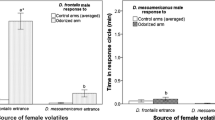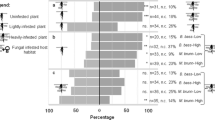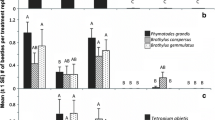Abstract
An increasing body of evidence indicates that the association between different plant species may lead to a reduction in insect herbivory, i.e. associational resistance. This might be due to a top–down regulation of herbivores by increased numbers of natural enemies or to a disruptive bottom–up influence of lower host plant accessibility. In particular, the richer plant communities release more diverse plant odours that may disturb olfactory-guided host choice and mating behaviour of insect herbivores, i.e. the “semiochemical diversity hypothesis”. However, this hypothesis has been rarely tested experimentally in natural habitats, notably forest ecosystems. We tested the effects of non-host volatiles (NHV) on mate and host location by the pine processionary moth (PPM) at the scale of individual pine trees with branches of non-host tree (birch) at their base. Pheromone trap catches and the numbers of larval nests were both reduced by non-host presence under treated pine trees, confirming an associational resistance mediated by NHV. In both males and females, the antenna could detect several birch volatiles, including methyl salicylate (MeSa). MeSa inhibited the attraction of the PPM male to pheromone traps, as did bark and leaf chips from birch trees. Our test of three doses of MeSa at the habitat scale (50 m forest edges) showed that the reduction in the numbers of male PPM captured in traps and in larval nests was MeSa dose-dependent. These results show that odours released by deciduous non-host trees can reduce herbivory by a forest defoliator in conifers, providing support to the “semiochemical diversity hypothesis” as a mechanism of associational resistance.


Similar content being viewed by others
References
Andersson MN, Larsson MC, Schlyter F (2009) Specificity and redundancy in the olfactory system of the bark beetle Ips typographus: single-cell responses to ecologically relevant odors. J Insect Physiol 55:556–567
Arn H, Städler E, Rauscher S (1975) The electroantennographic detector—a selective and sensitive tool in the gas chromatographic analysis of insect pheromones. Z Naturforsch 30:722–725
Atsatt PR, O’Dowd DJ (1976) Plant defense guilds. Science 193:24
Barbosa P, Hines J, Kaplan I, Martinson H, Szczepaniec A, Szendrei Z (2009) Associational resistance and associational susceptibility: having right or wrong neighbors. Annu Rev Ecol Evol Syst 40:1–20
Battisti A (1988) Host–plant relationships and population dynamics of the pine processionary caterpillar Thaumetopoea pityocampa (Denis and Schiffermuller). J Appl Entomol 105:393–402
Battisti A, Stastny M, Netherer S, Robinet C, Schopf A, Roques A, Larsson S (2005) Expansion of geographic range in the pine processionary moth caused by increased winter temperatures. Ecol Appl 15:2084–2096
Bedard C, Gries R, Gries G, Bennett R (2002) Cydia strobilelia (Lepidoptera : Tortricidae): antennal and behavioral responses to host and nonhost volatiles. Can Entomol 134:793–804
Borg-Karlson A-K, Eidmann HH, Lindström M, Norin T, Wiersma N (1985) Odoriferous compounds from the flowers of the conifers Picea abies, Pinus sylvestris and Larix sibirica. Phytochemistry 24:455–456
Brockerhoff EG, Jactel H, Parrotta JA, Quine CP, Sayer J (2008) Plantation forests and biodiversity: oxymoron or opportunity? Biodivers Conserv 17:925–951
Brouat C, McKey D, Bessiere JM, Pascal L, Hossaert-McKey M (2000) Leaf volatile compounds and the distribution of ant patrolling in an ant–plant protection mutualism: preliminary results on Leonardoxa (Fabaceae : Caesalpinioideae) and Petalomyrmex (Formicidae : Formicinae). Acta Oecol 21:349–357
Bruce TJA, Wadhams LJ, Woodcock CM (2005) Insect host location: a volatile situation. Trends Plant Sci 10:269–274
Campbell CAM, Pettersson J, Pickett JA, Wadhams LJ, Woodcock CM (1993) Spring migration of damson-hop aphid, Phorodon humuli (Homoptera, Aphididae), and summer host plant-derived semiochemicals released on feeding. J Chem Ecol 19:1569–1576
Demolin G (1969) Incidence of some factors affecting the social behaviour of larvae of Thaumetopoea pityocampa Schiff. (Lepidoptera) during the period of the pupation procession. Their repercussions on the effectiveness of parasites. In: Biological Control in the Forest’. Pont-a-Mousson
Engelberth J, Alborn H, Schmelz E, Tumlinson J (2004) Airborne signals prime plants against insect herbivore attack. Proc Natl Acad Sci USA 101:1781–1785
Finch S, Billiald H, Collier R (2003) Companion planting—do aromatic plants disrupt host-plant finding by the cabbage root fly and the onion fly more effectively than non-aromatic plants? Entomol Exp Appl 109:183–195
Geri C (1983) Population dynamics of the pine processionary caterpillar in the Niolo Valley, Corsica during the 1965–1966, 1967–1968 and 1969–1970 cycles. Role of some features of the forest environment. Ann Sci For 40:123–155
Gillette NE, Erbilgin N, Webster JN, Pederson L, Mori SR, Stein JD, Owen DR, Bischel KM, Wood DL (2009) Aerially applied verbenone-releasing laminated flakes protect Pinus contorta stands from attack by Dendroctonus ponderosae in California and Idaho. For Ecol Manag 257:1405–1412
Goff SA, Klee HJ (2006) Plant volatile compounds: sensory cues for health and nutritional value? Science 311:815
Hambäck PA, Beckerman AP (2003) Herbivory and plant resource competition: a review of two interacting interactions. Oikos 101:26–37
Hardie J, Isaacs R, Pickett JA, Wadhams LJ, Woodcock CM (1994) Methyl salicylate and (−)-(1R, 5S)-myrtenal are plant-derived repellents for black bean aphid, Aphis fabae Scop (Homoptera, Aphididae). J Chem Ecol 20:2847–2855
Heil M, Ton J (2008) Long-distance signalling in plant defence. Trends Plant Sci 13:264–272
Henning JA, Peng YS, Montague MA, Teuber LR (1992) Honey-bee (Hymenoptera, Apidae) behavioral response to primary Alfalfa (Rosales, Fabaceae) floral volatiles. J Econ Entomol 85:233–239
Himanen SJ, Blande JD, Klemola T, Pulkkinen J, Heijari J, Holopainen JK (2010) Birch (Betula spp.) leaves adsorb and re-release volatiles specific to neighbouring plants—a mechanism for associational herbivore resistance? New Phytol 186:722–732
Hudgins J, Franceschi V (2004) Methyl jasmonate-induced ethylene production is responsible for conifer phloem defense responses and reprogramming of stem cambial zone for traumatic resin duct formation. Plant Physiol 135:2134–2149
Hurlbert SH (1984) Pseudoreplication and the design of ecological field experiments. Ecol Monogr 54:187–211
Hurlbert SH (2009) The ancient black art and transdisciplinary extent of pseudoreplication. J Comp Psychol 123:434
Jactel H, Brockerhoff EG (2007) Tree diversity reduces herbivory by forest insects. Ecol Lett 10:835–848
Jactel H, Menassieu, P, Vetillard, F, Barthelemy B et al (2006) Population monitoring of the pine processionary moth (Lepidoptera : Thaumetopoeidae) with pheromone-baited traps. For Ecol Manag 235:96–106
Jakuš R et al (2003) Overview of development of anti-attractant based technology for spruce protection against Ips typographus: from past failures to future success. J Pest Sci 76:89–99
James DG, Grasswitz TR (2005) Synthetic herbivore-induced plant volatiles increase field captures of parasitic wasps. Biocontrol 50:871–880
Jayasekara TK, Stevenson PC, Hall DR, Belmain SR (2005) Effect of volatile constituents from Securidaca longepedunculata on insect pests of stored grain. J Chem Ecol 31:303–313
Kaitaniemi P, Riihimäki J, Koricheva J, Vehviläinen H (2007) Experimental evidence for associational resistance against the European pine sawfly in mixed tree stands. Silva Fenn 41:259–268
Kessler A, Baldwin IT (2001) Defensive function of herbivore-induced plant volatile emissions in nature. Science 291:2141–2144
Kessler A, Halitschke R, Diezel C, Baldwin IT (2006) Priming of plant defense responses in nature by airborne signaling between Artemisia tridentata and Nicotiana attenuata. Oecologia 148:280–292
Landolt PJ, Phillips TW (1997) Host plant influences on sex pheromone behavior of phytophagous insects. Annu Rev Entomol 42:371–391
Linn CE, Darnbroski HR, Feder JL, Berlocher SH, Nojima S, Roelofs WL (2004) Postzygotic isolating factor in sympatric speciation in Rhagoletis flies: reduced response of hybrids to parental host-fruit odors. Proc Natl Acad Sci USA 101:17753–17758
Markovic I, Norris DM, Phillips JK, Webster FX (1996) Volatiles involved in the nonhost rejection of Fraxinus pennsylvanica by Lymantria dispar larvae. J Agric Food Chem 44:929–935
Mauchline AL, Osborne JL, Martin AP, Poppy GM, Powell W (2005) The effects of non-host plant essential oil volatiles on the behaviour of the pollen beetle Meligethes aeneus. Entomol Exp Appl 114:181–188
McNair C, Gries G, Gries R (2000) Cherry bark tortrix Enarmonia formosana: olfactory recognition of and behavioral deterrence by nonhost angio- and gymnosperm volatiles. J Chem Ecol 26:809–821
Nakagawa S, Cuthill IC (2007) Effect size, confidence interval and statistical significance: a practical guide for biologists. Biol Rev 82:591–605
Norman G, Streiner D (2008) Biostatistics: the bare essentials. BC Decker, Hamilton
Nottingham SF et al (1991) Behavioral and electrophysiological responses of aphids to host and nonhost plant volatiles. J Chem Ecol 17:1231–1242
Perrin RM, Phillips ML (1978) Some effects of mixed cropping on the population dynamics of insect pests. Entomol Exp Appl 24:385–393
Prokopy RJ, Owens ED (1983) Visual detection of plants by herbivorous insects. Annu Rev Entomol 28:337–364
Reddy GVP, Guerrero A (2004) Interactions of insect pheromones and plant semiochemicals. Trends Plant Sci 9:253–261
Robinet C, Baier P, Pennerstorfer J, Schopf A, Roques A (2007) Modelling the effects of climate change on the potential feeding activity of Thaumetopoea pityocampa (Den. and Schiff.) (Lep., Notodontidae) in France. Glob Ecol Biogeogr 16:460–471
Root RB (1973) Organization of a plant–arthropod association in simple and diverse habitats—fauna of collards (Brassica oleracea). Ecol Monogr 43:95–120
Rosenthal R (1994) Parametric measures of effect size. In: Cooper H, Hedges LV (eds) The handbook of research synthesis. Sage, New York, pp 231–244
Schiebe C, Blazenec M, Jakus R, Unelius CR, Schlyter F (2011) Semiochemical diversity diverts bark beetle attacks from Norway spruce edges. J Appl Entomol 135 (in press)
Shulaev V, Silverman P, Raskin I (1997) Airborne signalling by methyl salicylate in plant pathogen resistance. Nature 385:718–721
Tahvanainen JO, Root RB (1972) The influence of vegetational diversity on the population ecology of a specialized herbivore, Phyllotreta crucifera (Coleoptera: Chrysomelidae). Oecologia 10:321–346
Tasin M, Bäckman AC, Bengtsson M, Ioriatti C, Witzgall P (2006) Essential host plant cues in the grapevine moth. Naturwissenschaften 93:141–144
Turlings TCJ, Ton J (2006) Exploiting scents of distress: the prospect of manipulating herbivore-induced plant odours to enhance the control of agricultural pests. Curr Opin Plant Biol 9:421–427
Unsicker SB, Kunert G, Gershenzon J (2009) Protective perfumes: the role of vegetative volatiles in plant defense against herbivores. Curr Opin Plant Biol 12:479–485
Vehvilainen H, Koricheva J, Ruohomaki K, Johansson T, Valkonen S (2006) Effects of tree stand species composition on insect herbivory of silver birch in boreal forests. Basic Appl Ecol 7:1–11
Visser JH (1986) Host odor perception in phytophagous insects. Annu Rev Entomol 31:121–144
Zhang Q-H, Schlyter F (2003) Redundancy, synergism, and active inhibitory range of non-host volatiles in reducing pheromone attraction in European spruce bark beetle Ips typographus. Oikos 101:299–310
Zhang Q-H, Schlyter F (2004) Olfactory recognition and behavioural avoidance of angiosperm non-host volatiles by conifer bark beetles. Agric For Entomol 6:1–19
Zhang QH, Schlyter F (2010) Inhibition of predator attraction to kairomones by non-host plant volatiles for herbivores: a bypass-trophic signal. PLoS ONE 5:e11063
Zhang Q-H, Birgersson G, Zhu JW, Löfstedt C, Löfqvist J, Schlyter F (1999) Leaf volatiles from nonhost deciduous trees: variation by tree species, season and temperature, and electrophysiological activity in Ips typographus. J Chem Ecol 25:1923–1943
Zhang Q-H, Schlyter F, Battisti A, Birgersson G, Anderson P (2003) Electrophysiological responses of Thaumetopoea pityocampa females to host volatiles: implications for host selection of active and inactive terpenes. J Pest Sci 76:103–107
Zhang Q-H et al (2006) Male-produced pheromone of the green lacewing, Chrysopa nigricornis. J Chem Ecol 32:2163–2176
Acknowledgements
We thank Mr P. Ménassieu and F. Vétillard for field assistance and M.Sc. Johannes Albertsson for moth maintenance and GC-EAD work. Funding was provided by grants from Formas no. 2003-1847 “Increasing biodiversity in forest landscape to improve resistance to pest insects” (INRA-Formas bilateral), from the Agence Nationale de la Recherche (ANR 07 BDIV 013-07-URTICLIM), and from the European Union (PROMOTH QLK5-CT-2002-00852); support also was provided by Formas, project no. 230-2005-1778 “Semiochemical diversity and insect dynamics”. The Linnaeus-program “Insect Chemical Ecology, Ethology and Evolution” (ICE3) funded by Formas and SLU provided infrastructure.
Author information
Authors and Affiliations
Corresponding author
Additional information
Communicated by Richard Karban.
Electronic supplementary material
Below is the link to the electronic supplementary material.
Rights and permissions
About this article
Cite this article
Jactel, H., Birgersson, G., Andersson, S. et al. Non-host volatiles mediate associational resistance to the pine processionary moth. Oecologia 166, 703–711 (2011). https://doi.org/10.1007/s00442-011-1918-z
Received:
Accepted:
Published:
Issue Date:
DOI: https://doi.org/10.1007/s00442-011-1918-z




